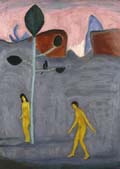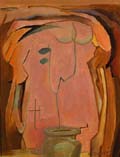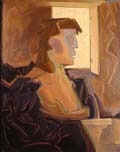manierre dawson: a pioneer
Read more about Manierre Dawson:
manierre dawson and the armory show
manierre dawson - recognition

Red Fort, 1907
Manierre Dawson
Click image to enlarge with caption.
The early work of Manierre Dawson (1887 – 1969) suggests an artistic presence at the beginning of the twentieth century in the heartland of the United States that is both surprising and prophetic. In their examination of formal concerns, their articulation of a personal vision, and their drive toward abstraction, the more than 160 paintings that burst forth between 1904 and 1918 demonstrate a vigorous and original hand that was unencumbered by academic training coupled with a level of visual sophistication that stretched far beyond Michigan Avenue in Chicago.

Adam and Eve, 1908
Manierre Dawson
Click on image to enlarge with caption.
Dawson was born in Chicago to a prosperous family. George Dawson, Sr. was a self-taught attorney, a student of the classics, and a master of seven languages. An older brother, George, Jr., was prepared for a professional career; his younger brother Mitchell eventually became an attorney. Lovell, the youngest sibling, diagnosed with spinal meningitis, was probably cared for by the three women of the household: Dawson’s mother Eva, his Grandmother Dawson, and his Aunt Kate Manierre.
His father’s decision to purchase land in Ludington, Michigan, as an escape for his family from the intensity of life in the burgeoning metropolis set the stage for an event that would significantly alter the arc of Dawson’s artistic career.

Rocky Pool, 1910
Manierre Dawson
Click on image to enlarge with caption.
George, Jr. graduated from high school in June of 1904. The Dawson boys planned an overnight camping trip with a friend in the woods across the lake from “The Humps,” as the family had affectionately nicknamed their retreat. George would paddle his homemade canoe on its maiden voyage and meet up with the others on the far bank. He never arrived. His body was found the next morning. Manierre had made no effort to find his brother and, although officially undocumented, probably felt the weight of responsibility not only for George, Jr.’s death but for fulfilling the family’s professional expectations that fell to him.

Two Nuts and Three Leaves, 1910
Manierre Dawson
Click image to enlarge with caption.
Dawson’s only formal art instruction came from several classes with Miss Dorothy Dimock at South Division (Wendell Phillips) High School in Chicago. In Miss Dimock’s classes the young man encountered the design philosophy of Arthur W. Dow’s influential instruction manual Composition, first published in 1899. Dow’s approach, filtered through the instruction of Miss Dimock, “encouraged beauty over representation.” 1The author’s dictum, “Abstract design is, as it were, the primer of painting, in which principles of composition appear in a clear and definite form,” spoke clearly to Dawson’s impressionable and open mind. The young man almost immediately began to paint works that were challenging by the standards of the day.
Read more about Manierre Dawson:
Manierre Dawson and the Armory show
Manierre Dawson – Recognition

Profile at Window, 1911
Manierre Dawson
Click image to enlarge with caption.
The curator wishes to acknowledge Manierre Dawson: American Pioneer of Abstract Art published by the Hollis Taggart Gallery as a source for much of the factual information about Manierre Dawson’s biography.
1Manierre Dawson: American Pioneer of Abstract Art; “The First American Abstractionist: Manierre Dawson and His Sources”; Essay by Randy J. Ploog; Hollis Taggart Galleries; New York, New York; 1999.
Read the Living Museum article, “Manierre Dawson: An Artist Out of Bounds” by Geoffrey Bates, Associate Curator of Art, ISM Lockport Gallery. Volume 68, number 1, Spring, 2006, pages 8-13 (as a PDF).